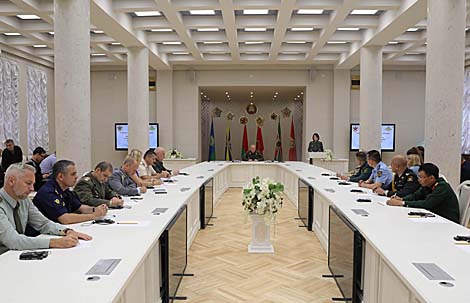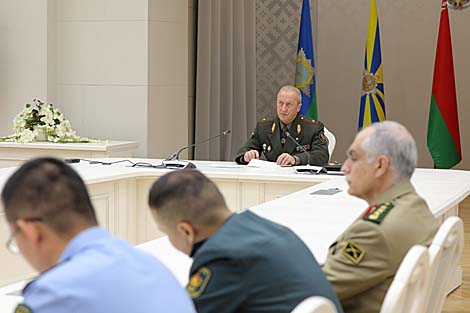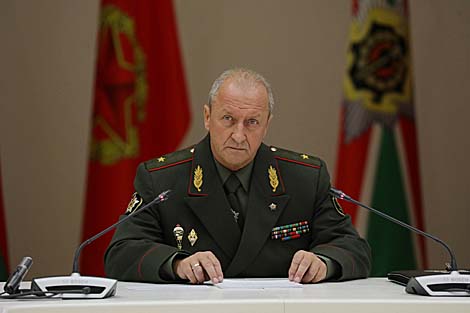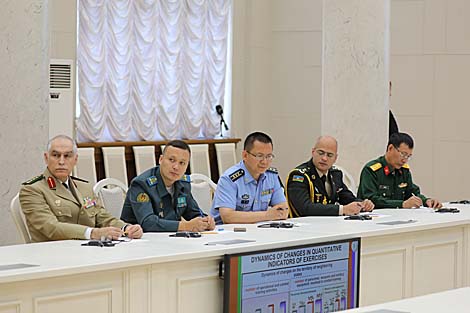Press releases
Over 4,000 Belarusian military to participate in Union Shield 2019 exercise

MINSK, 14 August (BelTA) – Over 4,000 Belarusian military personnel will take part in the Union Shield 2019 exercise, which will take place in Russia in September, BelTA learned from Chief of the General Staff, Belarusian First Deputy Defense Minister Oleg Belokonev on 14 August.
Military units of the Northwestern Operational Command and the Special Operations Command of the Armed Forces of Belarus are finishing their preparations for the Belarusian-Russian joint army exercise Union Shield 2019. The army exercise is scheduled to take place in the Mulino exercise area of the Western Military District of the Russian army in Nizhny Novgorod Oblast on 13-19 September. It will represent the final stage in the two-year cycle of joint combat training of Belarusian and Russian army units.
Oleg Belokonev will be the Belarusian supervisor of the exercise. Russia will be represented by Chief of the Western Military District of the Russian Federation Aleksandr Zhuravlev. The exercise will focus on preparing and using troops to ensure the military security of the Union State of Belarus and Russia. The exercise is expected to improve readiness levels and capabilities of command and control bodies, units of the regional military group as they work together to ensure the military security of the Union State of Belarus and Russia.
 Oleg Belokonev said: “The number of personnel and military hardware that will be involved in the exercise will not exceed the thresholds, which require mandatory observation in line with various arms control agreements. Plans have been made to deploy about 12,000 military personnel for the Union Shield 2019 exercise as well as up to 950 units of military hardware, up to 70 aircraft and helicopters. The Russian side notified states parties to the 2011 Vienna Document [on Confidence- and Security-Building Measures] about it in advance. Belarus will dispatch over 4,000 military personnel to Russia as well as over 30 combat tanks, 80 armored fighting vehicles, about 50 multiple-launch rocket systems, cannons and mortars, and about 15 aircraft and helicopters.” The personnel and the hardware will return to their permanent stations in Belarus by 4 October.
Oleg Belokonev said: “The number of personnel and military hardware that will be involved in the exercise will not exceed the thresholds, which require mandatory observation in line with various arms control agreements. Plans have been made to deploy about 12,000 military personnel for the Union Shield 2019 exercise as well as up to 950 units of military hardware, up to 70 aircraft and helicopters. The Russian side notified states parties to the 2011 Vienna Document [on Confidence- and Security-Building Measures] about it in advance. Belarus will dispatch over 4,000 military personnel to Russia as well as over 30 combat tanks, 80 armored fighting vehicles, about 50 multiple-launch rocket systems, cannons and mortars, and about 15 aircraft and helicopters.” The personnel and the hardware will return to their permanent stations in Belarus by 4 October.
Oleg Belokonev said: “The concept of the exercise has been worked out by analyzing possible threats to the military security of the Union State. Practice demonstrates that, as a rule, terrorists, separatists, illegal armed units assisted by outside parties get the ball rolling. Responding to this scenario will be practiced during the forthcoming exercise.”
In his words, despite the growing number of NATO exercises taking place in Eastern Europe near borders of the Union State of Belarus and Russia, the Union Shield 2019 exercise will take place deep inside Russia instead of areas near the border. It has been done to prevent tensions in Europe from climbing higher and to once again demonstrate Belarus’ and Russia’s willingness to reduce tensions in the region.
 During the exercise the army units will practice defending the border and destroying militant units, carrying out defensive actions and stabilizing the situation. The exercise will be split into two stages. Plans to use the regional military group will be made during the first stage over the course of three days. Army units will then practice taking action to prevent the situation in their areas of responsibility from getting destabilized. They will also finish preparations for combat action while having to deal with the enemy’s missile strikes and aircraft strikes. The second stage, which will last for four days, will focus on managing the troops, keeping communications lines open and getting the troops supplied in the course of defensive actions while measures are being taken to stabilize the situation.
During the exercise the army units will practice defending the border and destroying militant units, carrying out defensive actions and stabilizing the situation. The exercise will be split into two stages. Plans to use the regional military group will be made during the first stage over the course of three days. Army units will then practice taking action to prevent the situation in their areas of responsibility from getting destabilized. They will also finish preparations for combat action while having to deal with the enemy’s missile strikes and aircraft strikes. The second stage, which will last for four days, will focus on managing the troops, keeping communications lines open and getting the troops supplied in the course of defensive actions while measures are being taken to stabilize the situation.
“As Belarusian troops have to relocate to Russia and back, we will evaluate the transport infrastructure and its ability to move troops over long distances within the specified timeframe. It is another standard task all the armies have to deal with in the course of such exercises,” Oleg Belokonev said.
A joint staff has been set up for the duration of the exercise. Controllers have been appointed. Those are the most experienced and well-trained generals and officers, who can properly and thoroughly evaluate actions of command and control bodies and troops. A joint tactical exercise for engineer units of the Belarusian and Russian armies will be held prior to the Union Shield 2019 exercise. An instruction and briefing meeting will be held for top-ranking officers and controllers as well as a general instruction and briefing meeting.
 Belarus rigorously observes all the commitments undertaken within the framework of international and regional treaties on building up measures of trust and security. Belarus is ready to welcome foreign inspections and provide comprehensive information upon requests for verification activities, including during the regrouping of the Belarusian part of the troops.
Belarus rigorously observes all the commitments undertaken within the framework of international and regional treaties on building up measures of trust and security. Belarus is ready to welcome foreign inspections and provide comprehensive information upon requests for verification activities, including during the regrouping of the Belarusian part of the troops.
Oleg Belokonev noted that Belarus consistently and persistently pursues a peace-loving policy, puts efforts into reducing tensions in Eastern Europe, and supports all steps meant to enhance regional security. “For the sake of objective understanding and to prevent possible aggravation of the situation regarding the forthcoming exercise I would like to point out that the organization of joint exercises with allies is a normal practice in military training. Our closest neighbors arrange even larger exercises in their own territory regularly. And their exercises are not always defensive. In the course of such exercises involving the multinational contingent of NATO’s joint armed forces they practice troops deployment right next to the Union State border. The content of some of the tasks involves offensive action. They practice building up their forces, reconnoitering the routes for moving the troops, river crossing, assault landing, capturing facilities, compulsory evacuation of the local population ahead of military action, and many other things,” Oleg Belokonev said.
“An analysis of the largest NATO exercises such as Anakonda 2018 and Dragon 2018 demonstrates that unfortunately NATO continues thinking about possible ways to respond to crises and conflicts, which may emerge in the post-Soviet space, through force of arms. Their military training patterns are shifting from defensive and special operations to defensive and assault operations. We cannot but be concerned about it. However, Belarus does not talk about threats from the west and does not accuse anyone of aggressiveness the way we were ahead of the army exercise in 2017. It seems to us that some mass media and news sources on the Internet competed with each other in distributing blatantly false information or fake news. Two years later no forecasts made by the wannabe analysts have come true. There was no aggression and there was nothing close to it. The Russian component of the regional military force returned to the permanent stations fully and on time,” Oleg Belokonev stressed.







 print version
print version make home page
make home page add to bookmarks
add to bookmarks

